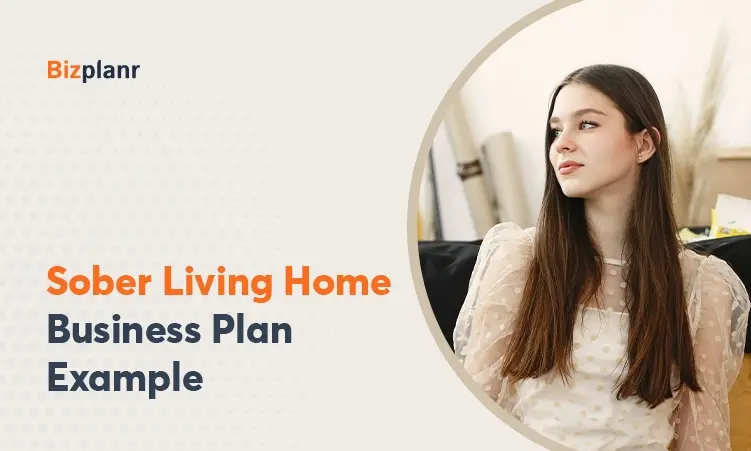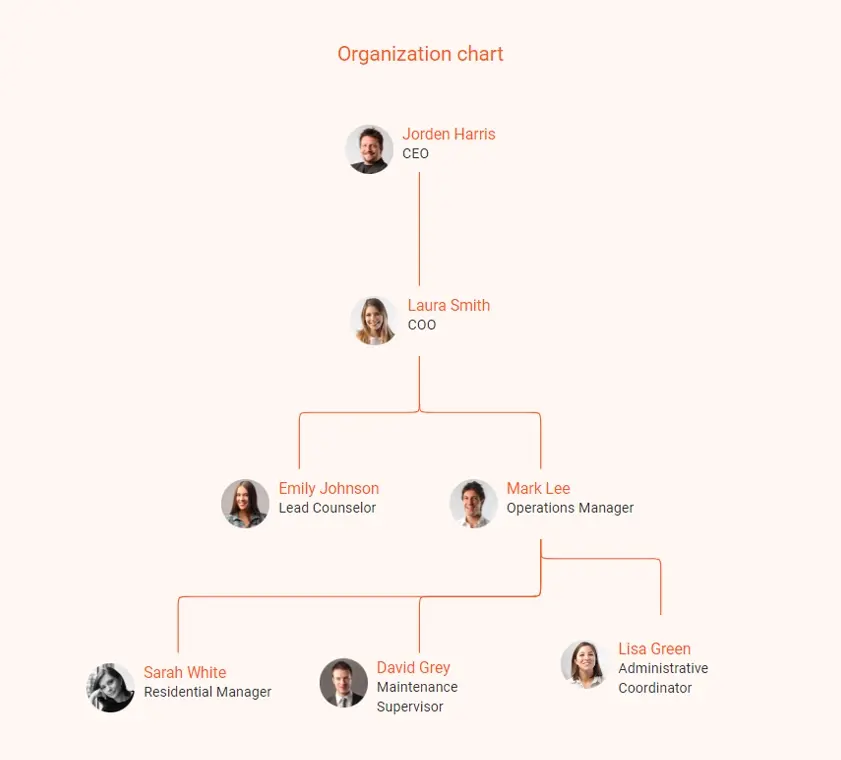Did you know that around 70% of individuals are struggling with alcoholism relapse but only 35.9% manage to recover and stay sober?
This shows the significant demand for supportive environments in the recovery process.
So, now is the perfect time to start your own sober living home if you've ever thought about helping people overcome substance abuse.
However, it requires careful planning and a well-thought-out business plan to navigate the complexities of the sober living home business and make it a success.
Need help writing your plan? Worry not!
This sober living home business plan template will be your reference point. It guides you on how to write essential sections of your plan effectively. But before that…
What is a Sober Living Home Business Plan?
A sober living home business plan is a professional document that outlines all the key strategies and elements for establishing or growing a sober living facility.
Typically, it includes comprehensive market analysis, target customers, services offered to assist resident recovery, initial funding requirements, and financial forecasts—to name a few items.
Additionally, this plan illustrates the business idea and its feasibility, profitability timelines, potential risks, and growth plans for the next 5-7 years.
Simply put, it's a strategic blueprint for sober living home founders and helps them win investor's confidence and secure loans.
Why do you need a Business Plan for a Sober Living Home?
Whether you're planning to start a new sober living home or expand an existing one, you'll require a business plan.
Here are several key reasons why you need to create a business plan for a sober living:
1) Clarifies vision and objectives
Writing a business plan instills clarity on your business idea, including the mission, vision, objectives, and milestones of your sober living home.
Further, it helps you define the key metrics, such as the number of residents, occupancy rate, revenue and profit goals, and recidivism/relapse rates for estimating the success of your business.
This allows you to compare actual results against plan targets and guide your decision-making to crystallize your path to success.
2) Ensures legal compliance
Well, opening and running a sober living facility requires strict adherence to various local, state, and federal regulations.
A professional business plan enables you to analyze all the zoning laws, licensing requirements, as well as health and safety standards.
This ensures that you address all legal aspects and operate a lawful sober living home, reducing the risk of legal issues.
3) Secures enough funding
Once you aim to start or expand a sober living home, you'll need significant capital investment for expenses (such as property acquisition or rent, renovations, furnishings, and payroll).
With the help of realistic financial planning, you can figure out the exact funding needs for launch and early business operations.
This clearly shows the amount you seek from investors or lenders and increases your chances of getting the required funds.
4) Identifies potential risks & challenges
While starting a sober living business, you might face fundamental risks, including resident safety concerns and local zoning issues.
However, during the planning process, you can identify and evaluate the potential challenges in operations, regulatory requirements, and legal compliance.
This will encourage you to develop effective risk mitigation strategies and address problems. Being ready with contingency plans ensure the long-term success and sustainability of your business.
5) Enhances business credibility
A well-crafted business plan shows stakeholders (especially residents of the sober living home and their families) that your business is properly managed and dedicated to providing high-quality care.
It also helps you build confidence in private investors and banks by showing them you've carefully evaluated all the business aspects. This will increase your chances of securing the necessary capital.
So, a solid business plan enhances your business's overall credibility with potential stakeholders.
All in all, creating a sober living home business plan is very essential to guide the strategic planning and sustainable growth of your sober living home.
How to Write a Sober Living Home Business Plan?
Writing a sober living home business plan involves several key steps to encapsulate your business. Here’s a detailed guide on how you would write each business plan section in detail.
1) Executive summary
An executive summary provides a quick introduction and comprehensive overview of your sober living home business.
Though it's the first and foremost section of your plan, writing an executive summary at the end (once all the key sections are ready) would be more convenient.
Why? Because it summarizes the most important aspects of your sober living home mentioned in the rest of your plan.
Ideally, your executive summary must include the following details apart from introducing your company.
- Business idea and purpose
- Mission-vision statements
- Market opportunities
- Unique value propositions
- Marketing and advertising plans
- Financial highlights
In short, this plan summary section should be impressive and compelling enough to capture the interest of your potential investors or stakeholders.
Liking the plan you're reading? It's AI generated.
Generate Your Own Using Bizplanr AI
2) Business overview
The business overview section gives an in-depth understanding of your sober living home. It highlights all the foundational elements and business-specific facts that every potential backer needs to know.
While drafting this section, you should consider including the following points:
- Business legal structure
- Location & reason for choosing that place
- Name of owners and partners
- Background history
- Milestones achieved (if any)
- Short-term goals and long-term objectives
Overall, this section presents your business concept in detail and outlines what your sober living home is all about. So, keep it concise yet engaging.
3) Industry and market research
This section offers a clear picture of the industry and market in which your sober living business intends to operate. It could be residential, post-rehab, and personal-care industries.
For thorough market analysis, you've to identify the market gap first and articulate how there is a need for your business. Then, it's necessary to get valuable insights into
- Market size & its growth potential
- Target customers analysis
- Key competitors
- Emerging market trends
- Regulatory compliance
In addition to that, you may conduct a SWOT analysis to explore all the positive and negative aspects of your sober living home as well as devise a successful strategy for the future. For example,
Doing so will help you easily identify the internal strengths and weaknesses of your business. Moreover, it helps you recognize the industry opportunities for further growth and external threats that might affect your business’s success.
This way, you show potential investors or stakeholders that you have a good understanding of the industry, potential clients, and how to differentiate your business.
4) Sales and marketing strategies
Your sales and marketing strategies will inform readers or potential stakeholders how you've decided to promote your sober living home and reach residents. It precisely includes all the marketing tactics, objectives, and sales approaches.
But being new in the market, you'll need to make a comprehensive marketing plan and understand the costs associated with each method.
The following are a few different ways you may consider to attract and retain residents:
- Using social media platforms (Instagram, Facebook, Twitter)
- Developing an SEO-optimized, professional website
- Engaging in direct email marketing campaigns
- Networking with local businesses or regional medical professionals
- Advertising through local media outlets and referral sources
While summarizing your strategies, be clear and concise in your messaging as a well-crafted plan can help you grow your customer base and ensure long-term success.
5) Services offered
As the name indicates, this section describes all the different types of services your sober living home will offer.
For instance, you may include a wide range of services, such as residential accommodation, drug testing, support and counseling, meal services, educational materials, life skill training, recreational activities, etc.
This will help readers better understand your offerings and how you plan to meet all your client’s needs and preferences. So, illustrate your services in a clear and precise manner.
6) Operations plan
In the operations plan section, you'll need to outline the day-to-day activities and processes required to run your sober living home smoothly. This will also help you achieve your business-specific goals.
So, try to draft your operational intricacies, clarify how they directly impact the quality of your services, and pique the reader’s attention.
Here’s the list of details you should incorporate in your operations plan:
- Staffing requirements and training
- Routine tasks (like onboarding, supervising, and providing individualized recovery plans)
- Facility management (resident guidelines, health and safety protocols)
- Equipment and technology used
Generally, this section gives a clear understanding of your business operations on a daily, weekly, monthly, and quarterly basis. So, don’t miss any essential points.
7) Management team
Next, highlight your sober living homes’ founders, key managers, and executive team members.
This section allows you to introduce your well-trained, strong management team, along with the professionals involved in addiction treatment, personal care, and property management.
So, consider including the roles and responsibilities, educational background, industry experience, and expertise of your executive team.
You may also create an organizational chart for the visual representation of your team structure and how the key roles interconnect. For example,
Moreover, you may describe your compensation plans and illustrate your advisory board members (if any).
Simply put, your management team section shows the capability and expertise of the individuals behind this venture and explains how they can add credibility to your business idea.
8) Financial projections
This is the most important aspect of your sober living business plan that helps you attract investors and secure funding. It offers a detailed analysis of your financial forecasts for the next few years.
Your sober living home financial plan must summarize a few critical financial statements and reports, such as:
- Initial startup costs
- Funding needs
- Sales & revenue forecasts
- Profit and loss statement (income statement)
- Balance sheet
- Cash flow estimates
- Break-even analysis
By developing comprehensive and realistic financial projections, you allow potential backers to make informed decisions and monitor your sober living home's fiscal health and viability.
Using advanced financial forecasting software can help you formulate complex financial projections more accurately and effectively without any hassle.
9) Appendix
The appendix of a business plan should contain additional information or supporting documents that don’t fit into specific sections but support the main content.
You should consider including the following details to make your sober living plan more compelling:
- Legal documents (permits, licenses, and contracts)
- Market research data and surveys
- Financial statements for tax return and credit history
- Marketing materials or operational procedures
- Resumes of the leadership team
This section will enable readers to get the necessary information easily and use it as a reference.
Conclusion
Now, that's a wrap! We've discussed all the key components of a sober living home business plan, such as an executive summary, market research, sales and marketing plan, operational aspects, and financial projections.
So, you have a clear idea of how to write a professional business plan for your sober living home.
However, drafting a comprehensive business plan from scratch can be an overwhelming and intimidating task. This is particularly true when you’re new to this game.
But not to worry. You may consider using a free AI business plan generator to build detailed business plans more effectively.
Simply answer a few easy questions and get your plan ready in minutes!
Get Your Business Plan Ready In Minutes
Answer a few questions, and AI will generate a detailed business plan.
Frequently Asked Questions
What are the next steps after creating a sober living home business plan?
Once, you've completed a sober living home business plan, consider following these essential steps:
- Secure enough funding
- Get necessary business licenses and permits
- Set up operational procedures
- Hire qualified staff
- Start promoting your sober living home
Are sober living homes profitable?
Of course! Opening sober living homes can be profitable businesses if you serve high-demand areas and manage operational costs effectively. However, its profitability depends on a few factors, like occupancy rates, operational efficiency, and the quality of services offered.
What should be included in the financial projections of my business plan?
In a sober living home business plan, you should consider including the following key financial projections:
- Revenue projections
- Startup costs
- Profit and loss statement
- Cash flow estimates
- Balance sheet
- Break-even analysis
- Funding requirements
Where to find grants to start a sober living?
You can explore these various sources of grants to start a sober living home:
- Government programs
- Private foundation grants
- Community fundraisers or nonprofit organizations
- Loans, partnerships, or sponsorships
- Corporate donations
Besides that, you can visit websites like Grants.gov and SAMHSA (Substance Abuse and Mental Health Services Administration) to find available grants for sober living homes.








